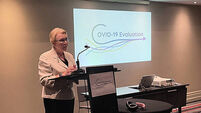Frontline ambulance: Advanced paramedic on collecting samples for Covid-19 tests


THE decision to use the ambulance service to collect samples from households around the country in a bid to combat the spread of Covid-19 is unprecedented, according to advanced paramedic Richard Quinlan, chief ambulance officer for the North Leinster region, who has paid tribute to the outstanding work being undertaken by frontline health service staff in the battle to contain the coronavirus outbreak.











